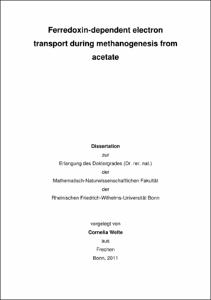Welte, Cornelia: Ferredoxin-dependent electron transport during methanogenesis from acetate. - Bonn, 2011. - Dissertation, Rheinische Friedrich-Wilhelms-Universität Bonn.
Online-Ausgabe in bonndoc: https://nbn-resolving.org/urn:nbn:de:hbz:5N-25858
Online-Ausgabe in bonndoc: https://nbn-resolving.org/urn:nbn:de:hbz:5N-25858
@phdthesis{handle:20.500.11811/5007,
urn: https://nbn-resolving.org/urn:nbn:de:hbz:5N-25858,
author = {{Cornelia Welte}},
title = {Ferredoxin-dependent electron transport during methanogenesis from acetate},
school = {Rheinische Friedrich-Wilhelms-Universität Bonn},
year = 2011,
month = sep,
note = {Methanogenic archaea are one of the key groups in global carbon turnover. They metabolize the conversion of the end products of the anaerobic food chain to methane. Of particular importance is the methanogenesis with acetate as substrate because it accounts for the majority of biologically produced methane. Only two genera are capable of methanogenesis from acetate, Methanosarcina and Methanosaeta. Their central methanogenic pathway is used for the production of reduced ferredoxin and the so-called heterodisulfide. In case of Methanosarcina mazei, a membrane-bound respiratory chain oxidizes the ferredoxin and transfers the electrons to the heterodisulfide with concomitant proton extrusion. A central aim of this work was to determine the ion-translocating activity of the ferredoxin-interacting membrane protein Ech hydrogenase. Ech hydrogenase was found to translocate protons in the course of ferredoxin oxidation and thus accounts for a new coupling site in methanogenic metabolism. Furthermore, Ms. mazei was searched for other ferredoxin-interacting proteins. Another membrane-bound protein could not be identified, but the soluble protein FpoF that is also part of the respiratory F420 dehydrogenase could be identified as ferredoxin: F420 oxidoreductase present in the cytoplasm. It is now clear that FpoF has a double function: first, as electron input module for the respiratory F420 dehydrogenase, and second, as a soluble protein in the cytoplasm.
After the in-depth characterization of the Ms. mazei respiratory chain, the membrane-bound electron transport system of Methanosaeta thermophila was investigated. This organism was found to possess a highly active ferredoxin: heterodisulfide oxidoreductase system presumably used for energy conservation. As a candidate for the ferredoxin-oxidizing membrane protein the F420 dehydrogenase lacking FpoF was proposed. This protein shares high homology with the well-characterized NADH dehydrogenase I (complex I). Due to the wide distribution of NADH/F420 dehydrogenase complexes lacking FpoF or NuoEFG, this complex could have a global role in ferredoxin oxidation.},
url = {https://hdl.handle.net/20.500.11811/5007}
}
urn: https://nbn-resolving.org/urn:nbn:de:hbz:5N-25858,
author = {{Cornelia Welte}},
title = {Ferredoxin-dependent electron transport during methanogenesis from acetate},
school = {Rheinische Friedrich-Wilhelms-Universität Bonn},
year = 2011,
month = sep,
note = {Methanogenic archaea are one of the key groups in global carbon turnover. They metabolize the conversion of the end products of the anaerobic food chain to methane. Of particular importance is the methanogenesis with acetate as substrate because it accounts for the majority of biologically produced methane. Only two genera are capable of methanogenesis from acetate, Methanosarcina and Methanosaeta. Their central methanogenic pathway is used for the production of reduced ferredoxin and the so-called heterodisulfide. In case of Methanosarcina mazei, a membrane-bound respiratory chain oxidizes the ferredoxin and transfers the electrons to the heterodisulfide with concomitant proton extrusion. A central aim of this work was to determine the ion-translocating activity of the ferredoxin-interacting membrane protein Ech hydrogenase. Ech hydrogenase was found to translocate protons in the course of ferredoxin oxidation and thus accounts for a new coupling site in methanogenic metabolism. Furthermore, Ms. mazei was searched for other ferredoxin-interacting proteins. Another membrane-bound protein could not be identified, but the soluble protein FpoF that is also part of the respiratory F420 dehydrogenase could be identified as ferredoxin: F420 oxidoreductase present in the cytoplasm. It is now clear that FpoF has a double function: first, as electron input module for the respiratory F420 dehydrogenase, and second, as a soluble protein in the cytoplasm.
After the in-depth characterization of the Ms. mazei respiratory chain, the membrane-bound electron transport system of Methanosaeta thermophila was investigated. This organism was found to possess a highly active ferredoxin: heterodisulfide oxidoreductase system presumably used for energy conservation. As a candidate for the ferredoxin-oxidizing membrane protein the F420 dehydrogenase lacking FpoF was proposed. This protein shares high homology with the well-characterized NADH dehydrogenase I (complex I). Due to the wide distribution of NADH/F420 dehydrogenase complexes lacking FpoF or NuoEFG, this complex could have a global role in ferredoxin oxidation.},
url = {https://hdl.handle.net/20.500.11811/5007}
}






